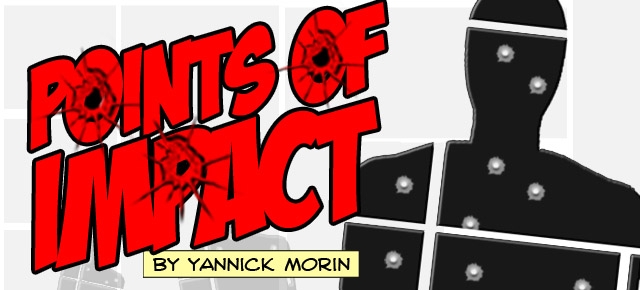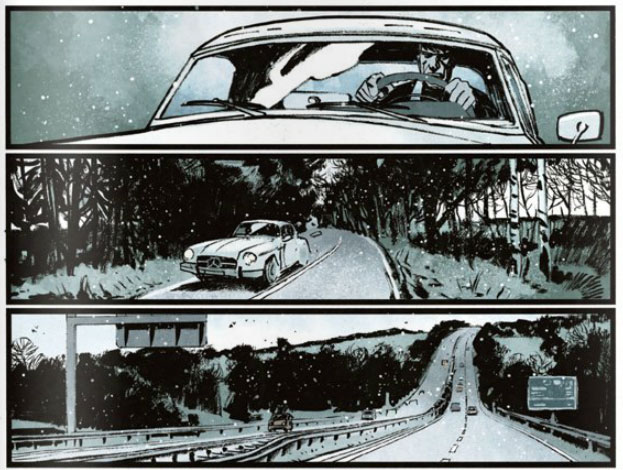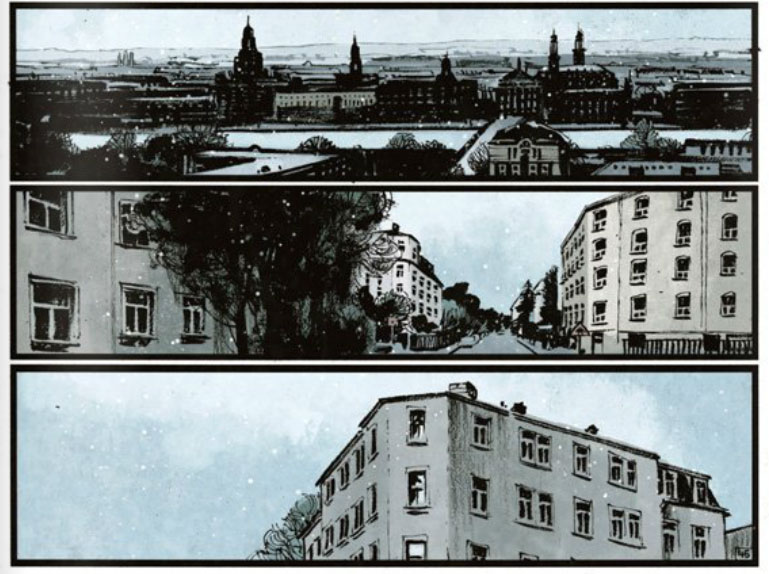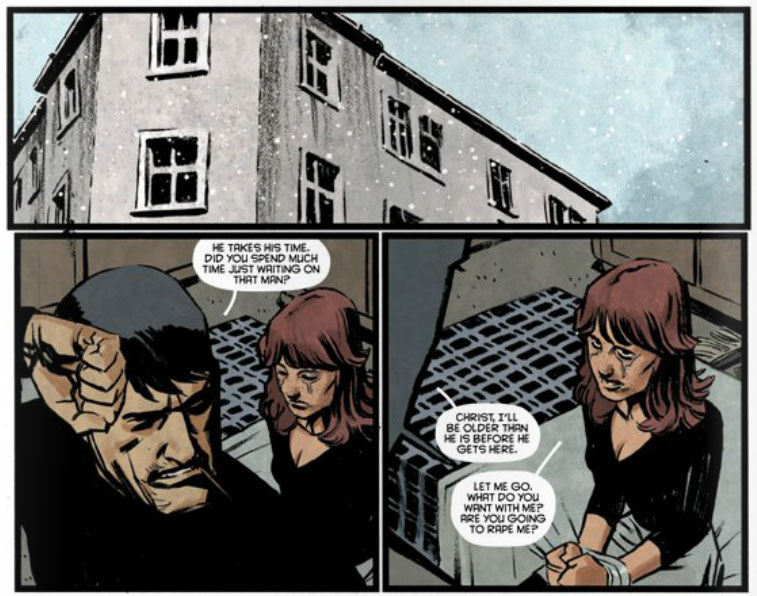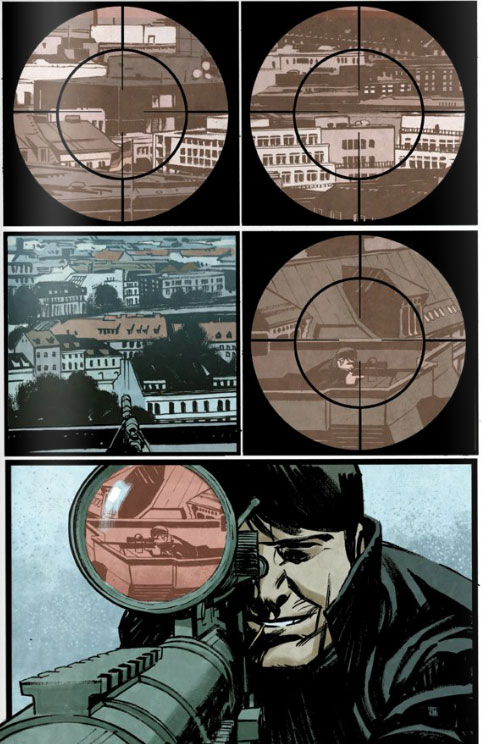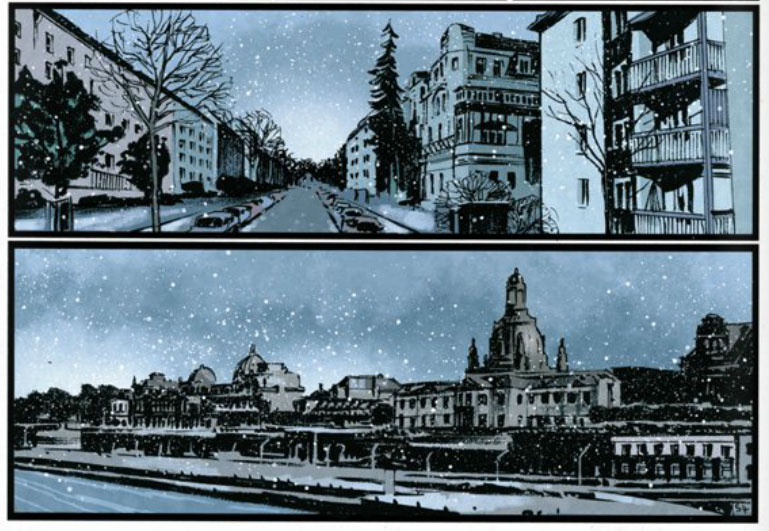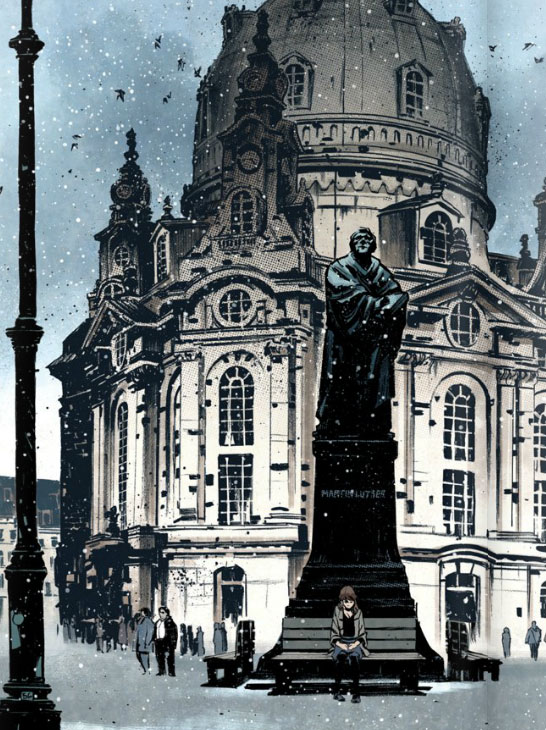Points of Impact – Week 16: Location, Location… You Know the Rest
1st Disclaimer: Points of Impact contains so many spoilers it can practically replace reading your comics. Know what that means? Read your comics first!
2nd Disclaimer: For the sake of simplicity and since it’s impossible for me to know exactly who did what for the specific elements I usually examine, unless the creators come forward themselves to set me straight, from now on I’ll assume that everything in the comic stems from a joint decision by both the artist and the writer. I figure I’ll get it right most of the time if I give each 50% of the credit. I apologize in advance if I’m off from time to time, but I’d rather give too much credit than not enough where it’s due.
The eloquent camera work in Nathan Edmondson and Nic Klein’s DANCER #3 of 5
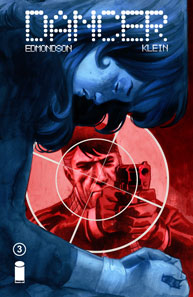 Location is something that is often taken for granted in comics. This is hardly suprising. After all, haven’t we accustomed ourselves to the easy way out? Just slap a caption in the corner of that panel and be done with it! Wide shot, caption, wham-bam, thank you… kind reader. It’s almost become an afterthought, an administrative formality that we execute with the grace of a civil servant. It’s a curtesy we extend to the reader, quickly pointed out and then forgotten, not unlike those placards they used to place at the side of the stage: “The Forest” or “The City”.
Location is something that is often taken for granted in comics. This is hardly suprising. After all, haven’t we accustomed ourselves to the easy way out? Just slap a caption in the corner of that panel and be done with it! Wide shot, caption, wham-bam, thank you… kind reader. It’s almost become an afterthought, an administrative formality that we execute with the grace of a civil servant. It’s a curtesy we extend to the reader, quickly pointed out and then forgotten, not unlike those placards they used to place at the side of the stage: “The Forest” or “The City”.
We’ve learned the “proper” way to execute that business efficiently and in doing so, we’ve lost the value there was in location. It’s been relegated to the status of mere decor, an accessory to fill in the void behind the characters, a tool to beat back the dreaded fluorescent color fills and geometric patterns of the dark 90’s. Sadly, comics cannot afford the luxury that movies enjoy. For us, there’s no possible set piece, no minute-long traveling shot to set the mood. We got 22 pages and no more! So chop-chop and get to the talky-talky!
And then again, sometimes, there’s this one comic whose creators decide to break the mold. Imagine a comic where location plays such a large role that t practically takes as much place as the characters in terms of allotted panel count. Imagine that comic and you’ll imagine DANCER #3 by Nathan Edmondson and Nic Klein.
Yes, DANCER again. Three issues into that miniseries and each previous one has been the recipent of a BULLSEYE. (Why don’t you take a break and go read here and here? I’ll wait.)
When we last parted with the cast, YEA (Young Evil Alan) had kidnapped Quin, the girlfriend of the original – and now much older – Alan. The malevolent clone is using the girl as bait to draw his genetic “father” out and – what else? – shoot him. It’s a fascinating game of cat-and-mouse that’s playing out since the first issue, with predator and prey constantly trading places. At the same time, location is playing the same kind of game with the characters in DANCER #3; it keeps grabbing the spotlight throughout the book, all the while offering an amazing display of camera work.
There are numerous examples that I could use to demonstrate my point but I’ll stick to the three that stand out the most in my opinion. Besides, if I discussed every camera angle in the book, you’d still be reading this by the time Points of Impact – Week 17 came out.
I’m going to start you off easy with the first page that presents us with two series of silent shots. The first three panels show Alan driving towards Dresden, the German city where YEA is holed up with Quin.
What do we have?
1.1 – Medium shot of Alan in his car
1.2 – Wider shot of the car on a country road (that’s a nice Mercedes by the way)
1.3 – Long shot of the autobahn*
*That’s what they call the highway system in Germany, not what I do to people who disrespect Scott Snyder on our forums.
We then cut to three more panels – all silent still, not even a caption! – but this time, it’s another subject altogether. Heck, I’ll even cheat and include the first three panels on the following page to better drive my point home afterwards.
Now we have:
1.4 – Wide aerial shot of Dresden
1.5 – Long shot of a Dresden street
1.6 – Wide shot of a building
2.1 – Tighter shot of the same building
2.2 – Medium shot of YEA and Quin inside the building
Notice how, in the first sequence, the camera is moving away from the character, actually making him disappear entirely from the picture; not even his car can be seen in that third panel! And then, the camera switches locations – as if it had just used the autobahn itself – and transports us to Dresden proper. The following panels takes us further into the city, effectively zooming in, as if we’d just used the same function in Google Maps, stretching the limts of Street View to include the interior of our final target location.
Since we can practically see the camera moving from one location to the other, we get a better idea of the distance between the two locations. Not only that, but the zooming in and out confers a certain physicality to our point of view. The camera has to take the time to travel; there’s no instant teleportation through the magic of captions. It’s as if we were there. What this does is engage the reader even more since the camera work effectively places us right at the spot of the action.
Following closely on the heels of the opening set-up is another scene that uses some cool camera tricks. Crafty Alan knows that the kidnapping is a setup and has every intention of not getting tricked. Using his knowledge of what he would do, he hunkers down at the optimal position to catch YEA at his own game. These are the panels we get:
4.5 – Behind Alan’s shoulder shot of Dresden
5.1 – Scope view of Dresden
5.2 – Same scope view of Dresden – panned a bit to the right
5.3 – Alan POV of Dresden
5.4 – Scope view of Alan
5.5 – Tight shot of YEA with reverse shot of the last panel in his rifle scope
Did you see that little trick of sleight-of-hand that Edmondson and Klein pulled off there? They have Alan set up with his scoped rifle, taking care to show you what he sees by using a behind-the-shoulder shot. When the panels switch to scope views, you’d naturally assume that these were from Alan’s POV, right? Wrong! They’re what YEA is seeing; the buildings in those shots are completely different. The panned view and subsequent zooming in are there to suggest YEA’s actions, that is looking for Alan!
Now where did we see this before? It does seem awfully familiar, no? Yup, it’s another narrative shortcut – a match cut to be more precise – just like Edmondson and Klein used in DANCER #2. This time however, instead of using actions to execute the match cut, they’re using location. In this case, it’s the similarity of the shown locations that serves as a transition element. And unless you’re particularly familiar with the Dresden cityscape, it also serves in delaying the revelation of the danger in which Alan is placed.
The final example I wanted to discuss appears just before the big climax of this issue. YEA has left Alan a message to come and find him in Neumarkt Square. (Just for fun, check out this photo and you’ll appreciate how much work Nic Klein has put into recreating this real-world location.) But first, the camera has to take us there!
So off we go, down the street (panel 10.4) and along the Elbe river with the majestic cuppola of the Church of Our Lady profiled on the horizon (panel 10.5). Once again, the camera reaffirms our engagement into this story by literally transporting us from location to another. Once arrived however, it has a new trick for us:
We’re first shown a wide shot of the plaza – a proper establishing shot – with Alan placed prominently in the foreground to establish his presence at this new location. what follows however is a set of panels that work in pairs. The first pair is a close-up going from a medium to a tight shot of Alan, facing us. The function of these panels is merely to make sure we see Alan’s reaction to what he’s saying. Next comes the tricky part: the next two panels are shots of Quin sitting on a bench – and she’s securely fastened to it by a bicycle lock! As if this wasn’t enough, the page-turn hides another surprise:
BAM! Splash page! Quin is not only tied to a bench; she’s tied to a bench just under the statue of Martin Luther! Go back to that photo I’ve shown you earlier; that statue is dead center in front of the church. That means there’s no way for Alan to approach her without being seen – and you know that YEA is watching!
What this last shot does is that it drives home the dramatic situation, that is the conflict that Alan must resolve: how can he get to Quin without getting shot? In this case, the camera work is used to underline that conflict faced by the protagonist, to clarify its parameters so that the reader can fully appreciate its severity. Indeed, if the conflict is primarily based on the location – as an action set piece – there needs to be panel space devoted to its thorough presentation. Otherwise, if it’s relegated to simple scenery, the reader is missing out on information needed to understand the nature of the conflict as well as the plausibility and feasibility of the solutions considered by Alan. When plot points hang in the balance, captions just won’t cut it!
In essence, what Edmondson and Klein did was the opposite of what got them their last BULLSEYE: instead of using special techniques to save up on panel space, they actually burn through it faster by devoting it to location. However, these silent panels – where locations stands in for characters and traveling stands in for action – serve a worthy purpose: by engaging the reader and contributing to doling out information, they heighten the dramatic tension, thus ensuring the reader a truly memorable experience.
The same way a sniper’s work relies on mastering the terrain and using it to his best advantage, Edmondson and Klein demonstrate a masterful understanding of location and how to use camera work to make it an agent for drama.
Thus, for their brilliant use of camera direction, Nathan Edmondson and Nic Klein score a BULLSEYE with DANCER #3.
Lesson Learned
When given enough space, location can be used to great effect, be it: engaging the reader, creating surprise revelations and enhancing the dramatic tension born of the stated conflict. Be aware however that using the techniques described in this column require an expenditure of panel space that can easily eat up a sizeable portion of your page count in the long run. The solution to this problem? Narrative shortcuts! (Yeah, that link again!)
Honorable Mentions
- Scott Snyder and Dustin Nguyen devote a fourth of AMERICAN VAMPIRE: LORD OF NIGHTMARES #2 of 5 to an expository flashback that’s so well integrated that it’s painlessly swallowed despite its size.
- In CONAN THE BARBARIAN #6, Brian Wood and James Harren cultivate a palpable sense of urgency through both dialogue and art.
- Brian Wood gets another honorable mention, this time with artist Kristian Donaldson for THE MASSIVE #2 with its drama-filled flashback that doesn’t take the reader out of the flow of the main narrative.
- Kudos for the French in PETER PANZERFAUST #5, Kurtis Wiebe! Haha, just kidding! You and Tyler Jenkins get your kudos for that mostly silent scene of the Germans marching into Paris. The scene was treated with the perfect tone that the subject deserved, despite the usual quirkiness of the book.
- PUNK ROCK JESUS #1 by Sean Murphy was just jam-packed with content but was so well-paced that it never suffered from such density.
- Scott Snyder again! (It was a very Snyder-intensive week.) SWAMP THING #1 (artist: Marco Rudy) has a great sequence of back-and-forth point of views. Oh and nice photo for the SDCC ad by the way!
Dishonorable Mentions
- You can’t win ’em all, Scott! BATMAN #11 (with art by Greg Capullo) contains an ungodly six pages of spoken epilogue that is so unwieldy it could have just been inserted as prose in the back material.
- I’m going to go against the flow and give Robert Kirkman and Charlie Adlard’s THE WALKING DEAD #100 a dishonorable mention. To put it bluntly, I have the nagging feeling that I’ve read this before, back when that villain was named the Governor. Despite the emotional impact that is undeniably present, it still feels like the same impact we periodically get in the unending cycle that THE WALKING DEAD is starting to let show: safety, glimpse of happiness and catastrophy. In other words: it’s my favorite flavor of ice cream – AGAIN.
And there you have it! See you soon!
Please click here to make comments in the forum!
Related Posts:
Category: Columns, Points Of Impact

